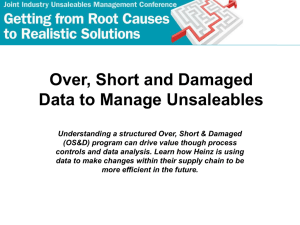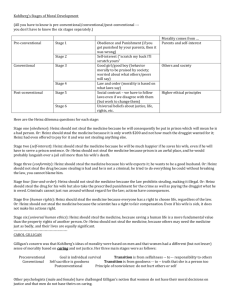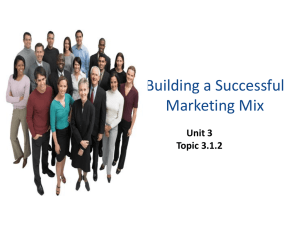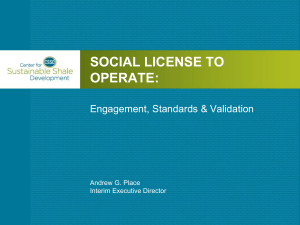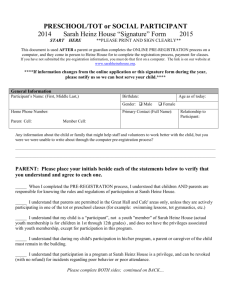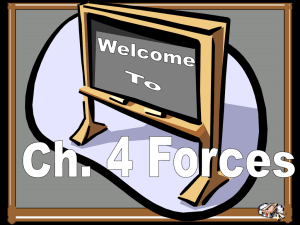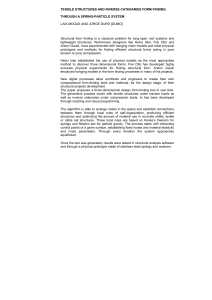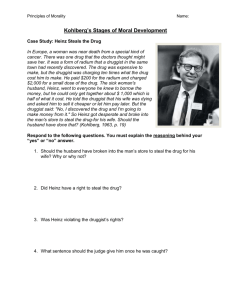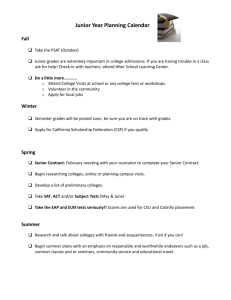Unit 2 - Lesson 4, Morality
advertisement
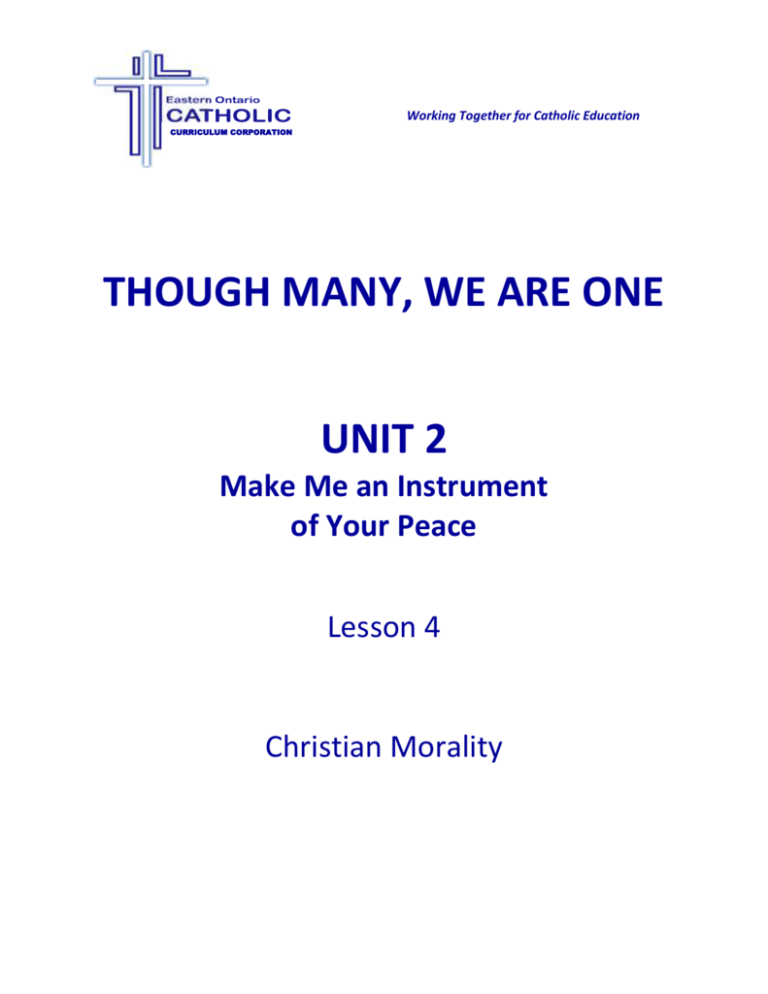
Working Together for Catholic Education CURRICULUM CORPORATION THOUGH MANY, WE ARE ONE UNIT 2 Make Me an Instrument of Your Peace Lesson 4 Christian Morality CURRICULUM CORPORATION Though Many, We Are One - Religious Education for Combined Junior Grades Unit 2 Lesson 4 Christian Morality Make Me An Instrument of Your Peace Lesson Overview Moral development and the Golden Rule. Duration: 160 minutes – 4 class periods ONTARIO CATHOLIC SCHOOL GRADUATE EXPECTATIONS & CATHOLIC SOCIAL TEACHINGS CURRICULUM CONNECTIONS Religious Education: Gr. 5 – ML2 Demonstrate an understanding of conscience as a source of help in judging our moral actions and our responsibility for the results of our actions. The Ontario Catholic School Graduate Expectations evident in this lesson include: Gr. 6 - ML2.3: Apply a Catholic model of moral decision-making (i.e. SEE, JUDGE, and ACT) to ethical issues that arise at school or in the world (bullying, fighting, failing to do homework, and disrespecting authority). CGE1d -develops attitudes and values founded on Catholic social teaching and acts to promote social responsibility, human solidarity and the common good; Literacy Connections: Oral CGE3a -recognizes there is more grace in our world than sin and that hope is essential in facing all challenges; CGE1a -illustrates a basic understanding of the saving story of our Christian faith CGE1i -integrates faith with life; 1.2 demonstrate an understanding of appropriate listening behaviour by adapting active listening strategies to suit a variety of situations, including work in groups CGE4c -takes initiative and demonstrates Christian leadership; CGE4g -examines and reflects on one’s personal values, abilities and aspirations influencing life’s choices and opportunities; Reading 1.5 develop interpretations about texts using stated and implied ideas to support their interpretations CGE5d -finds meaning, dignity, fulfillment and vocation in work which contributes to the common good; 1.6 extend understanding of texts by connecting, comparing, and contrasting the ideas in them to their own knowledge, experience, and insights, to other familiar texts, and to the world around them. CGE7a -acts morally and legally as a person formed in Catholic traditions; 1 EOCCC – Though Many, We Are One Unit 2, Lesson 4 CURRICULUM CORPORATION Though Many, We Are One - Religious Education for Combined Junior Grades Guiding Questions (coming out of the Big Idea) Big Idea: The Catholic Catechism starts the section on Catholic morality with St. Leo the Great's beautiful words: Morality is a call to recognize our dignity as men and women who have received a free gift of new life in Christ. We must live accordingly. Scripture Passages: Proverbs 16:9 “The heart of man plans his way, but the Lord establishes his steps.” Philippians 4:8 “Finally, brothers, whatever is true, whatever is honorable, whatever is just, whatever is pure, whatever is lovely, whatever is commendable, if there is any excellence, if there is anything worthy of praise, think about these things.” LEARNING GOALS At the end of this lesson, students will know, understand and/or be able to: Understand that in conjunction with mental and physical growth, we grow morally as well Understand that there is a set of beliefs and theories with how we develop morally Be able to draw on Catholic Teachings to help them make decisions Success Criteria, based on the Learning Goals, can be co-constructed as a class in language meaningful to students. The success criteria help students understand what to look for during the learning and what it looks like once they have learned. They identify the significant aspects of student performance that are assessed and/or evaluated (i.e., the “look‐fors”) in relation to curriculum expectations. INSTRUCTIONAL COMPONENTS AND CONTEXT Terminology: Materials: Natural Moral Law – is inscribed in the heart Pencils Lined sheets of paper and known by human reason Catechism Internet Resources: Golden Rule Hero Making good choices http://youtu.be/B2VG7aKxO0c Resources: Golden Rule https://www.scarboromissions.ca/Golden_rule/ind ex.php Appendices 2 EOCCC – Though Many, We Are One Unit 2, Lesson 4 Though Many, We Are One - Religious Education for Combined Junior Grades CURRICULUM CORPORATION MINDS ON • Establishing a positive learning environment • Connecting to prior learning and/or experiences • Setting the context for learning Propose the follow questions for discussion: (10 minutes) What if we didn’t know right from wrong? Do we hold all people up the same moral standard (age, physical and mental ability)? Every day we are giving a chance to choose between good and evil. Moral decision making 1. You find a wallet in the park with a great deal of money in it. What do you do? (What if you kept the money and gave it to charity? What if you gave it to the police? What if someone saw you pick it up and asked for it?) 2. Your best friend tells you something in confidence that could be dangerous. Do you keep the secret? (Who you tell and why you tell is important) ACTION • Introducing new learning or extending/reinforcing prior learning • Providing opportunities for practice and application of learning (guided independent) Part 1 (30 minutes): The world is filled with lots of grey areas. Fortunately we have a few places to draw upon to help make the picture clearer. Refer to Appendix A – A Guide to Moral Decision Making. Part 2 (80 minutes): Minds On: Ask the class “Would it be fair if kindergarten students were treated the same as students in junior grades? Why or why not?” Introduce the Golden Rule: “Do unto others as you would have them do unto you.” We develop a conscience as we mature. Refer to Appendix B - Kohlberg’s Stages of Moral Development Part 3 (40 minutes): Heinz Dilemma – Refer to Appendix C Also included is the breakdown of the choice the students can make. It is important to explain to the student that how they justify their choice is really important. You can choose to share the six stages with the students, orally read them, or project them on the board. 3 EOCCC – Though Many, We Are One Unit 2, Lesson 4 CURRICULUM CORPORATION Though Many, We Are One - Religious Education for Combined Junior Grades CONSOLIDATION • Providing opportunities for consolidation and reflection • Helping students demonstrate what they have learned Journal Reflection: 1) How has what you learned over the past 4 lessons changed the ways you approach decision making? Has it? CONTINUED LEARNING OPPORTUNITIES Further extensions to this lesson might include: Keeping a journal about choices they have made over the course of the week. Explore the Golden Rule teachings in greater detail. (See Scarboro Missions web site – especially Golden Rule curriculum) Assist student to examine their conscience in preparation for the sacrament of Reconciliation. 4 EOCCC – Though Many, We Are One Unit 2, Lesson 4 CURRICULUM CORPORATION Though Many, We Are One - Religious Education for Combined Junior Grades Appendix A Catechism and You: A Guide to Moral Decision Making Catechism 1749 What is a catechism? A catechism is a summary of the main ideas in Christian religious teaching. It usually comes in the forms of questions and answers. It is meant to be used as instructions for Christians. THE MORALITY OF HUMAN ACTS We are all responsible for the actions we take. Since God gave us free will, we are responsible for all of our actions. All human acts are freely chosen and need to be evaluated. There are three steps to every act we chose 1) The choice we have made (virtue, sin) or the act. Some acts are always good (honesty) and some are always evil (lying). 2) The end in view or the intention (what we wanted the outcome to be) 3) The circumstances of the action (reason why we did something) All three make up any decision 1) The choice if reflected outward – this is the choice we see and the immediate consequence 2) The intention can only be found inside the person. If the act was done by choice. For instance, helping a charity can be a pure act that is inspired by Gods love. But if we do it to brag about it to our friends, the intent takes away from the good. A good intention (helping a neighbour) does not make a behavior (lying) good or just. 3) Circumstances can change how good or evil an act is. For instance theft could be dependent on how much is taken and from whom. For instance if you steal a piece of bread to feed the poor. A morally good act is one that has a good intention, the goodness of the act and the end result. An evil action can never be justified by having a good intention. There are some acts that are good and some that are always morally evil. One may not do evil so that good may result from it. Let have a look at some decisions we may make and see if we can classify them as good or evil and why. 1. Mary goes to school and realizes that she forgets to study for her math test. She decides that is going to copy her neighbour's work because she needs the mark to pass. 2. A local charity is coming to the classroom. Mike walks to the back of the room and grabs a $20.00 bill from his backpack, making sure that everyone can see as he donates it. 3. Sam is building a project for the science fair. His little sister keeps bothering him so he decides to yell at her to get away. He feels bad about it, but his science project needs to get done. 4. Your mom gets a new haircut and you think it’s ugly. When she asks you what you think, you say it looks great. You need your allowance after all 5 EOCCC – Though Many, We Are One Unit 2, Lesson 4 CURRICULUM CORPORATION Though Many, We Are One - Religious Education for Combined Junior Grades Possible break down of answers 1) The act is bad (lying). Mary’s intention is to lie to the teacher and the end result is that she will get a mark she doesn’t deserve. She will not have learned something she may need to know. 2) The act is good (charity). However, the intention (to show off) is bad even though the end it goes to a good cause. This is an example of how we can do the right thing, but for the wrong reasons 3) The act is bad (yelling, insulting). The intention to get his work done is good and Sam may have needed to work away from his sister; however, there are other ways he may have gone about it. 4) The act is bad (lying). The intention is good (not hurting your mom’s feelings); however the end result is your mom may have to walk around with a bad haircut. Someone else may tell her it is unattractive. Can you come up with your own scenario and break it down. Think about it in 3 steps 1) Is the action a virtue or a sin? 2) What are you hoping to be the final outcome? 3) Are there circumstances that justify the actions? 6 EOCCC – Though Many, We Are One Unit 2, Lesson 4 CURRICULUM CORPORATION Though Many, We Are One - Religious Education for Combined Junior Grades Appendix B Kohlberg’s Stages of Moral Development Stages of moral development are supported by parental input. Children must be given a good basis during their early years. 1. 2. 3. 4. 5. Infant - Do not have a moral basis but do feel “right” when being fed and nurtured and “wrong” when needs are not being met. Toddler – Others share their world and there are rules to abide by as directed by the toddler’s caregiver. Pre-schoolers (3-7 years) – Family values become apparent. Children begin to understand the Golden Rule as well as consequences. Seven to ten year olds – Understand that rules are necessary and what is most beneficial for them. They learn to negotiate. Pre-teen – Teen – Live with peer pressure but have the ability to make good moral decisions. Moral development moves from what is right because it feels right to its right because that is what we should do. What to do with this information? 1) Think of an example when you have seen someone follow the golden rule. What did it look like? 2) During recess, bring out a sheet of paper and observe how the kindergarten or early primary interact with one another. What do you notice about the way they play? Did you see the Golden Rule be demonstrated? 3) Write a short narrative piece that focuses on the theme of “The Golden Rule”. The story is to be aimed at a primary audience and must include 1 climax and at least 2 characters. The setting can be anywhere Reason for writing – to explain to a younger student The Golden Rule Audience – Primary aged students Form – fictional narrative Topic – The Golden Rule – the best way you think you can get it across to students. Remember younger students do not have the same life experience as you, so you will need to make the story relevant to them. 7 EOCCC – Though Many, We Are One Unit 2, Lesson 4 CURRICULUM CORPORATION Though Many, We Are One - Religious Education for Combined Junior Grades Appendix C Heinz Dilemma Heinz’s wife was dying from a particular type of cancer. Doctors said a new drug might save her. The drug had been discovered by a local chemist and the Heinz tried desperately to buy some, but the chemist was charging ten times the money it cost to make the drug and this was much more than the Heinz could afford. Heinz could only raise half the money, even after help from family and friends. He explained to the chemist that his wife was dying and asked if he could have the drug cheaper or pay the rest of the money later. The chemist refused saying that he had discovered the drug and was going to make money from it. The husband was desperate to save his wife, so later that night he broke into the chemist’s and stole the drug. Kohlberg asked a series of questions such as: 1. Should Heinz have stolen the drug? 2. Would it change anything if Heinz did not love his wife? 3. What if the person dying was a stranger, would it make any difference? 4. Should the police arrest the chemist for murder if the woman died? 1) What would you have chosen and why? Make sure you take the time to explain why you have chosen what you would do. 8 EOCCC – Though Many, We Are One Unit 2, Lesson 4 CURRICULUM CORPORATION Though Many, We Are One - Religious Education for Combined Junior Grades Appendix C - possible justification of choices: Stage one (obedience): Heinz should not steal the medicine because he will consequently be put in prison which will mean he is a bad person. Or: Heinz should steal the medicine because it is only worth $200 and not how much the druggist wanted for it; Heinz had even offered to pay for it and was not stealing anything else. Stage two (self-interest): Heinz should steal the medicine because he will be much happier if he saves his wife, even if he will have to serve a prison sentence. Or: Heinz should not steal the medicine because prison is an awful place, and he would more likely languish in a jail cell than over his wife's death. Stage three (conformity): Heinz should steal the medicine because his wife expects it; he wants to be a good husband. Or: Heinz should not steal the drug because stealing is bad and he is not a criminal; he has tried to do everything he can without breaking the law, you cannot blame him. Stage four (law-and-order): Heinz should not steal the medicine because the law prohibits stealing, making it illegal. Or: Heinz should steal the drug for his wife but also take the prescribed punishment for the crime as well as paying the druggist what he is owed. Criminals cannot just run around without regard for the law; actions have consequences. Stage five (human rights): Heinz should steal the medicine because everyone has a right to choose life, regardless of the law. Or: Heinz should not steal the medicine because the scientist has a right to fair compensation. Even if his wife is sick, it does not make his actions right. Stage six (universal human ethics): Heinz should steal the medicine, because saving a human life is a more fundamental value than the property rights of another person. Or: Heinz should not steal the medicine, because others may need the medicine just as badly, and their lives are equally significant. 9 EOCCC – Though Many, We Are One Unit 2, Lesson 4
